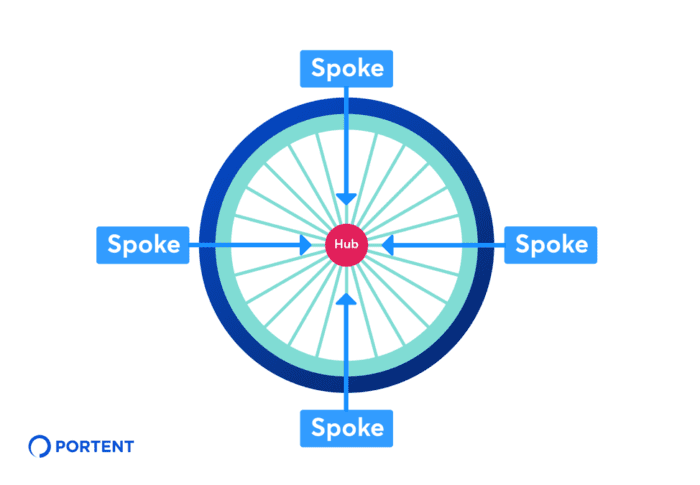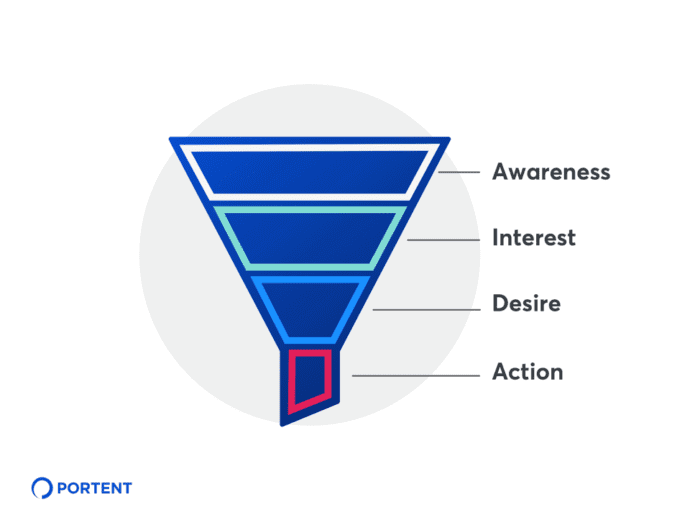Content hubs help you solve the problem of related content being disconnected across your site and can help grow your organic rankings for target keywords
You may not be familiar with the term “content hub,” but you’ve likely heard of the concept by some other name. You may have heard it referred to as a “topic pillar” or perhaps a “content cluster,” but what you call it doesn’t really matter.
Content hubs help you solve the problem of related content being disconnected across your site and can help grow your organic rankings for target keywords. Beyond this, content hubs can help you increase your on-site conversions and goal completions.
What is a content hub?
Content hubs are a linking strategy in which you:
- Identify most or all content on your site related to a central topic.
- Choose a core “hub” page that you want to rank well for the topic.
- Link all of the “spoke” pages back to the identified hub page and (where possible) link from the hub page out to the spoke pages.

So, why does the simple act of linking together similar content improve your site’s user experience and organic visibility? There are numerous benefits to content hubs, but the following three are what I would consider the most important.
1. Content hubs build your brand’s authority
Whether looking from the perspective of SEO, content strategy, or user experience, we know that it’s difficult (if not impossible) to fully cover a broad topic with just one webpage. However, if you publish blog posts, articles, or other pages about a subject without interlinking them, your users will have trouble finding all of your content easily.
Connecting these resources throughout your site with descriptive anchor text builds your authority on the topic by showing the wealth of subject-matter content you have. Users who discover you through a single article on a topic will have an easier time staying on your site and reading more content if you have a hub strategy in place.
The beauty of the content hub strategy is that you’re not limited to just one! I recommend building out a content hub for any and all topics that you have sufficient content for. Show off your brand’s knowledge and expertise on subjects and tie those pages together so search engines and users can easily find them.
2. Hubs increase your site’s visibility and traffic
There wouldn’t be much point to writing about content hubs if they didn’t work.
One of my industrial manufacturing clients was trying, without much success, to rank for ‘plastic injection molding’. They had a lot of great content on the topic and a solid service page, but they couldn’t get it to rank for the keyword.
Our team helped them implement a content hub strategy in December 2017 (see arrow in the image below).

Client’s averaged desktop and smartphone rankings for ‘plastic injection molding’. After a three-month ranking gap, the site climbs to ranking 9th in the top right of the graph.
It took a few months before the hub had the impact we wanted. When it did, our client was ranking as high as the ninth position in Google results for this high-volume keyword.
For a client starting a new streaming service, we were able to build content hubs into their website from launch. It’s challenging to get organic traction when a new site is launched, but they’ve experienced nonstop growth in large part thanks to content hubs.

Client’s organic traffic (users) by month since launch, as reported by Google Analytics.
Consolidating your internal linking around a single page helps search engines understand what you think deserves to rank for a given query.
3. Content hubs generate more leads
In addition to increasing organic traffic, content hubs can help move users through your site in a way that increases leads.
Your central content hub, as described above, is the page you chose as your target landing page for a topic. In most cases, the hub page will be a service page (if you’re working with a services-focused website) or another page designed for conversions, such as a top-level product category page on an e-commerce site. If the hub page you choose is not optimized for conversions, you should either optimize the page or go with a different page that’s already set up for conversions.
The selected hub page will not only receive more organic traffic but also more internal traffic from its spoke pages. Every new link that you create from one page on the site back to the hub page is a new pathway for users to follow. Those long-tail searchers landing on the spoke pages will then enter into your conversion funnel. An optimized content hub helps users move down the marketing funnel and lead them to convert.

Finally, a content hub can do more than improve the traffic to the hub page. If you design your content hub to link out to the spoke pages, then they will benefit as well.
Bonus advice: don’t forget about backlinks!
A content hub’s success is built on the idea of funneling link authority from several topically related pages into a single hub page. However, that only works well if your spoke pages have backlinks!
Backlinks are necessary, but they sometimes feel like a thorn in the side of SEO professionals. If you don’t have an established process for earning backlinks, you should try to construct your content hub around a topic that already has pages with backlinks. If you do have a successful method for building links, don’t just focus on the hub page. Ideally, your spoke pages and hub page should all receive backlinks from diverse but relevant sources.
Final thoughts
Of course, no single digital marketing tactic can succeed in a vacuum. The content hub strategy is just one tool that you can add to your toolkit and use alongside other successful processes. If you don’t have the right content for a hub, perform keyword research to identify new blog posts to write. If your content hub is earning the traffic you were hoping for, but it’s not converting, perform conversion-rate optimization to improve lead generation.
One of the best things about a content hub is that it’s relatively easy to implement. Identifying related pages and linking them together is something anyone with access to edit a site can do.
